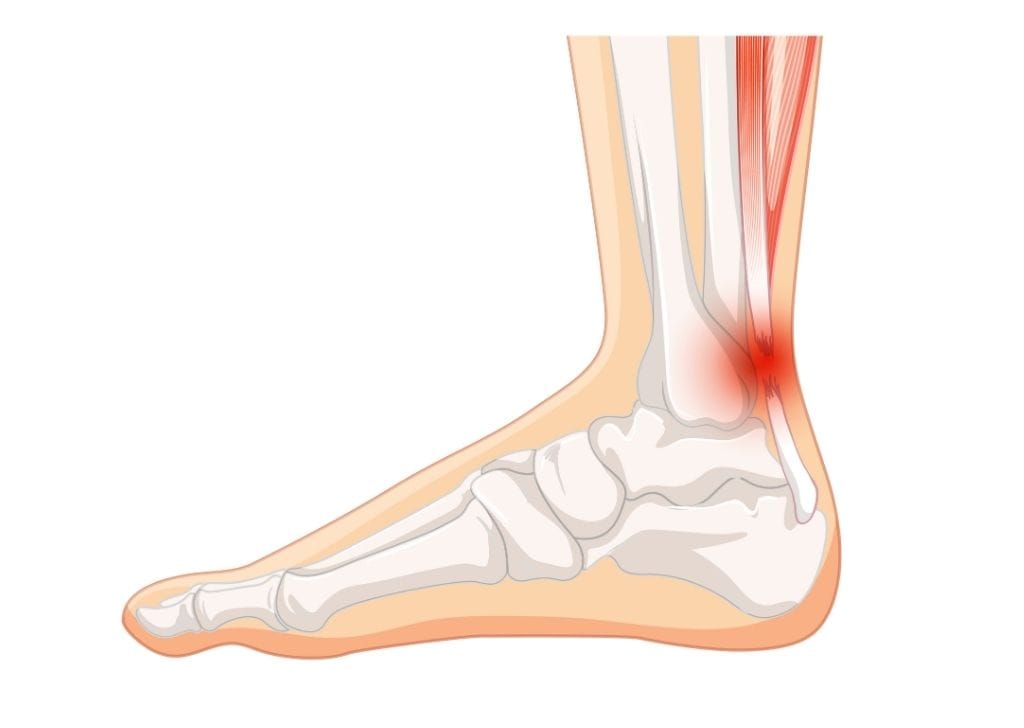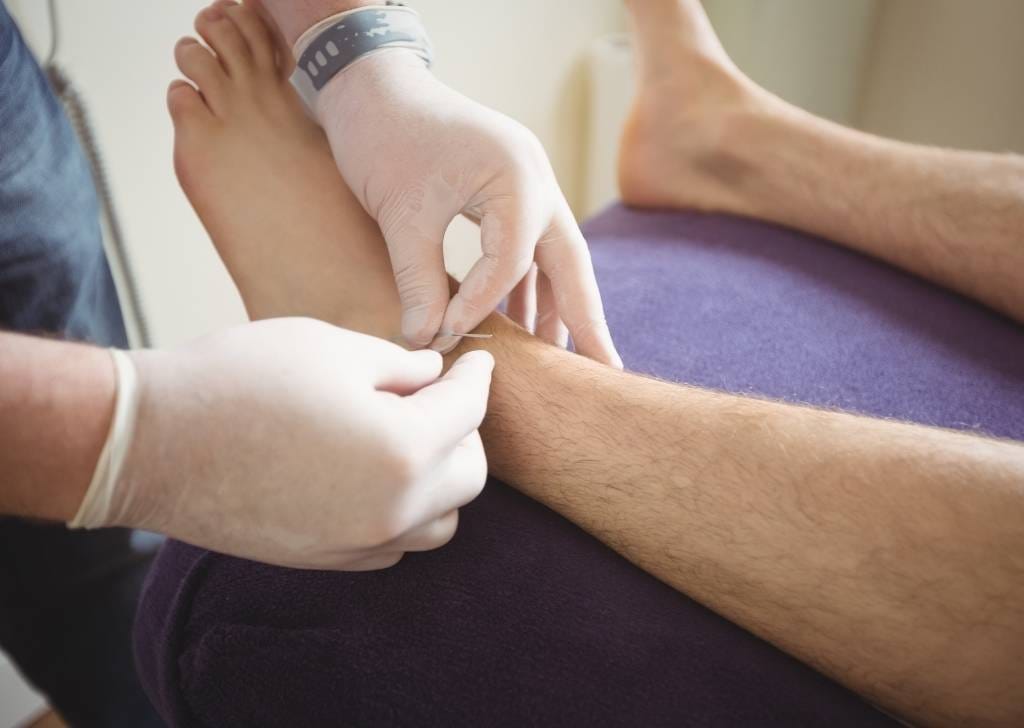If you’re dealing with persistent heel pain when walking, there’s a high chance it’s due to plantar fasciitis – a condition we regularly treat with dry needling physiotherapy here at Regenesis Physiotherapy Subang Jaya. By targeting the actual source of pain deep within the connective tissue, dry needling helps you move pain-free again.
Let’s break down what causes this heel pain and how our physio approach tackles it effectively.
What Causes Heel Pain When Walking?
Heel pain is not just inconvenient, it can be downright debilitating. Whether it’s that sharp stab in the morning or a lingering ache after long hours on your feet, the root causes often go ignored until they become chronic.
Plantar Fasciitis – The Most Common Culprit
This is the leading cause of heel pain, particularly the kind felt on the bottom of the heel. The plantar fascia is a thick band of connective tissue that supports your arch. Overuse, poor footwear, or even biomechanical imbalances can inflame this tissue leading to plantar fasciitis heel pain.
You’ll usually feel this:
- First thing in the morning
- After sitting or standing for a long time
- After a run or intense walk
When the fascia is overstretched repeatedly, micro-tears develop and inflammation sets in. Left untreated, this worsens over time, and the pain can spread toward your arch or Achilles tendon.
Signs You Might Have Plantar Fasciitis Heel Pain

If you’re experiencing sharp heel pain when walking, especially during your first steps in the morning, there’s a high chance you’re dealing with plantar fasciitis. This common condition results from inflammation of the plantar fascia — the thick band of tissue connecting your heel bone to your toes.
At Regenesis, we often see these hallmark signs among patients who come for plantar fasciitis physiotherapy:
1. Heel Pain in the Morning
You wake up and the first few steps feel like walking on nails. This stiffness usually eases as the foot “warms up” but can return after long periods of sitting or standing.
2. Pain After Long Periods of Standing or Activity
If your job requires prolonged standing, or you’ve just finished a long walk, a dull ache or stabbing pain can develop in the heel area.
3. Pain Localised to the Bottom of the Heel
The pain is often centralised to one spot — under the heel — but it can sometimes radiate into the arch of your foot.
4. Pain That Improves with Movement, Then Returns
Unlike injuries that worsen with movement, plantar fasciitis may improve with light activity, only to return later in the day.
Why Does Plantar Fasciitis Happen?

Repeated stress on the plantar fascia—without enough rest or recovery—causes tiny tears in the tissue. Over time, these tears trigger inflammation and chronic pain. While many assume rest alone will solve it, without targeted plantar fasciitis physiotherapy, the tissue fails to heal properly, resulting in persistent symptoms.
Risk Factors for Plantar Fasciitis
- Overuse from sports like running or dancing
- Poor footwear without arch support
- Flat feet or high arches
- Sudden weight gain which puts more load on your heel
- Tight calf muscles or Achilles tendon limiting ankle mobility
These factors combined can overload the plantar fascia, eventually causing micro-trauma.
Why It’s Crucial to Treat Heel Pain Early
Ignoring plantar fasciitis heel pain can turn a manageable condition into chronic discomfort that limits your mobility and quality of life. The sooner you start treatment, the better your chances of full recovery — without invasive procedures.
At Regenesis, our experienced team offering dry needling in Subang Jaya has helped many patients treat heel pain effectively at its source.
1. Prevents Chronic Pain
Left untreated, plantar fasciitis can develop into long-term pain that spreads up the leg or affects how you walk — leading to hip, knee, or back issues.
2. Improves Day-to-Day Function
Early treatment with dry needling for plantar fasciitis and physiotherapy means getting back to walking, working, and exercising without hesitation or fear of flare-ups.
3. Avoids Overcompensation Injuries
When your heel hurts, you tend to shift your weight unnaturally, which can strain other parts of your body, including your knees and lower back.
Does Dry Needling Permanently Cure Plantar Fasciitis?
Dry needling is not a one-time cure, but when done consistently alongside structured physiotherapy sessions, it significantly accelerates recovery.
Patients in Regenesis often report:
- Reduced morning heel stiffness
- Less pain when walking or climbing stairs
- Improved foot flexibility
- Faster return to activity or sport
This makes it one of the most effective non-invasive heel pain treatment options in Malaysia
How We Use Dry Needling To Treat Heel Pain

Dry needling is one of the most effective techniques used at Regenesis to reduce pain and inflammation caused by plantar fasciitis. While many treatments focus only on symptoms, dry needling works by targeting the root cause of heel pain—tight or irritated muscle fibres and fascia.
How Dry Needling Works
Using fine, sterile needles, your physiotherapist inserts them into specific trigger points—often in the calves or foot—to release muscle knots and improve blood flow. This process helps relax the plantar fascia, reduce tension, and kickstart the body’s natural healing response.
For those experiencing heel pain when walking or chronic plantar fasciitis heel pain, this treatment can significantly reduce recovery time.
Why It’s Effective for Plantar Fasciitis
Plantar fasciitis is often linked to overuse, poor foot biomechanics, and tightness in surrounding muscles. By applying dry needling for plantar fasciitis, we relieve pressure on the inflamed tissue directly. Patients often report less morning stiffness and better mobility within a few sessions.
Combined with manual therapy, shockwave treatment, and rehabilitative exercises, dry needling forms part of a comprehensive plantar fasciitis physiotherapy approach.
Home Exercises That Help Relieve Plantar Fasciitis Heel Pain
Alongside dry needling and physiotherapy, simple at-home exercises can make a real difference in recovery. At Regenesis, we often prescribe targeted exercises as part of a personalised heel pain treatment plan to restore flexibility and reduce tension.
Calf Stretch on Wall
This stretch targets the tight calf muscles that can strain the plantar fascia. Stand facing a wall with one foot behind the other. Keep the back leg straight and heel on the floor, lean forward slowly. Hold for 30 seconds, switch legs. Repeat 2–3 times per leg.
Towel Stretch
Before getting out of bed, use a towel or resistance band to pull your toes toward you while keeping your leg straight. This simple move helps reduce the intense heel pain in the morning.
Toe Curls with Towel
Place a small towel on the floor, grip it with your toes, and pull it toward you. This exercise strengthens foot muscles that support your arch, improving foot mechanics.
Rolling Stretch with Frozen Bottle
Roll the sole of your foot over a frozen water bottle for 5–10 minutes. This acts like a gentle massage and icing therapy, perfect after a long day of walking.
Our physiotherapists in Regenesis Subang Jaya will teach you how to safely perform these exercises for plantar fasciitis heel pain during in-clinic sessions, and design a plan you can follow at home.
When to See a Physiotherapist for Heel Pain Treatment
If your heel pain doesn’t improve with rest, or it’s been affecting your daily movements like walking, climbing stairs, or standing for long periods, it’s time to seek professional help. At Regenesis Physiotherapy in Subang Jaya, we specialise in diagnosing and treating plantar fasciitis heel pain through evidence-based techniques, including dry needling and functional rehabilitation.
Key Signs You Shouldn’t Ignore:
- Persistent heel pain when walking or standing
- Sharp pain in the morning or after long periods of sitting
- Swelling or warmth in the heel area
- Pain that worsens with activity, especially after exercise
If you’re experiencing any of these, it’s likely not just temporary soreness. Our team of experienced therapists will guide you through a structured heel pain treatment plan tailored to your lifestyle, work demands, and severity of symptoms.
You’ll also receive guidance on corrective exercises for plantar fasciitis heel pain, ergonomic footwear recommendations, and follow-up to ensure long-term results.
Frequently Asked Questions (FAQ) – Plantar Fasciitis Heel Pain
Heel pain can come from plantar fasciitis, heel spurs, Achilles tendinitis, or even nerve issues. A physiotherapist can confirm with an assessment of your foot mechanics and pain patterns.
Sometimes mild cases improve with rest and footwear changes, but persistent or recurring pain usually needs physiotherapy, exercises, or treatments like dry needling.
Most patients report improvement within 3–6 sessions, but this varies based on the severity of your heel pain and how your body responds to treatment. A tailored treatment plan from your physiotherapist ensures the best outcome.
Yes, especially if the root cause (like poor footwear or overuse) isn’t addressed. Preventive stretches and supportive shoes are key to avoiding recurrence.
Yes. While dry needling is highly effective, it’s just one of several treatment options we use for plantar fasciitis. Depending on your condition, alternatives may include:
Manual therapy & soft tissue mobilisation – to reduce tension in the fascia and surrounding muscles.
Shockwave therapy – stimulates healing in chronic cases where the fascia has microtears.
Therapeutic exercises – targeted stretches and strengthening to restore flexibility and support your arch.
Footwear advice & orthotics – ensuring proper arch support to reduce strain on the heel.
Taping or bracing – to offload pressure from the plantar fascia during activity.
For many patients, the most effective approach is a combination of these therapies rather than relying on a single treatment. A physiotherapist will assess your foot mechanics, daily habits, and pain severity to tailor the best plan for you.
Ready to Walk Pain-Free Again?

If you’re tired of waking up to sharp heel pain or struggling with every step, it’s time to take control. At Regenesis Physiotherapy in Subang Jaya, we specialise in targeted heel pain treatments that combine dry needling, manual therapy, and tailored rehabilitation plans.
Whether you’re dealing with chronic plantar fasciitis heel pain, acute injuries, or lingering muscle tension, our licensed physiotherapists are here to help you get back on your feet—literally.
Book a consultation today and explore our dry needling therapy for plantar fasciitis, or browse our full physiotherapy services in Subang Jaya to find the best option for your needs.
Let Regenesis guide you to long-term relief without surgery, without guesswork.
Book an appointment today and get a tailored recovery plan that fits your condition and lifestyle. Let Regenesis help you regain your movement, strength, and confidence without unnecessary medication or surgery.






